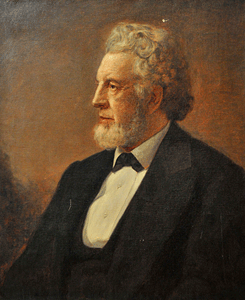| Join | Official Historian, City of Stamford | Blog | About Us | |
| Jewish Historical Society | Civil War Roundtable | Contact Us | |
|
|
|
|
The Stamford Historical Society PresentsBest Face Forward
|
 |
Oil on canvas Wyatt Eaton (1849–1896) M572k-3 Gift of Dr. Katharine K. Merritt |
From modest beginnings on a Connecticut farm to becoming one of the most successful business men of the period, Joseph B. Hoyt founded Hoyt Bros. in New York City which became one of the largest companies in the leather trade. His political life was limited to being a member of the Connecticut House of Representatives for two years. His obituary states “He was commonly credited, and we presume correctly, with being ‘the richest man in Stamford.’ ”
In addition to his business activities, he served many years on the American Baptist Mission Society Executive Board as well as being a pillar in Stamford Baptist Church where he was Superintendent of the Sunday school and a deacon. Minister of the church, Dr. Edward J. Lathrop and his wife, lived for many years with the Hoyt family in their spacious home, “Blachley Manor” on Noroton Hill.
Wyatt Eaton was born in Philipsburg, Quebec of American parents. As an apprentice in his father’s carriage works, he began to paint and draw on his own. He was encouraged to enroll at the National Academy of Design in New York City and took private lessons for five years with Joseph Oriel Eaton a noted portrait specialist.
Returning to Philipsburg in the summer of 1868, he received several portrait commissions and painted rural landscapes. One client, a banker and patron of the arts, funded his study in Europe. In London he met the American painter, James McNeil Whistler and in Paris he became a close friend of Jean-Francois Millet, who at that time was considered them aster of genre painting. Eaton’s first major genre painting, “Harvesters at rest” was greatly influenced by Millet’s style and it was later exhibited at the National Academy of Design.
Eaton joined the faculty of the Cooper Union where he taught drawing and portraiture and was in great demand as a portraitist. He did a series of portraits of authors and poets which were engraved for use in Scribner’s Monthly.
He was a founding member of the American Art Association and the Society of Canadian Artist. His works are found in many museums, including the Museum of Fine Arts in Boston and the National Gallery of Canada in Ottawa.
His promising career was cut short when in 1896 he died of tuberculosis at age forty-seven.
Blachley Lodge, Noroton Hill, c. 1892
Image © Stamford Historical Society